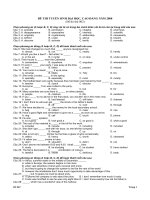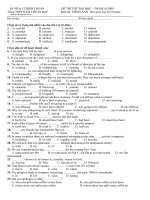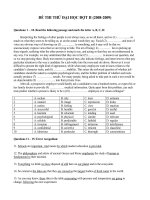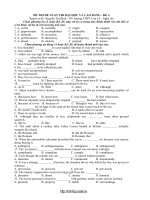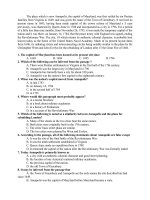Đề thi thử đại học môn tiếng anh 16
Bạn đang xem bản rút gọn của tài liệu. Xem và tải ngay bản đầy đủ của tài liệu tại đây (92.71 KB, 8 trang )
The place which is now Annapolis, the capital of Maryland, was first settled by ten Puritan
families from Virginia in 1649, and was given the name of the Town of Greenbury. It received its
present name in 1695, having been made capital of the crown colony of Maryland a 5 year
previously, was chartered by Queen Anne in 1708 and incorporated as a city in 1796. For a period
of a little less than nine months, from November 26, 1783, it was made the temporary capital of the
nation and it was there, on January 14, 1784, that the peace treaty with England was signed, ending
the Revolutionary War. The city, 10 which retains its authentic colonial character, is probably best
known today as the home of the United States Naval Academy. Much of its present layout dates
from 1696, its radiating streets and interconnecting circles being notably similar to the plans by Sir
Christopher Wren and John Evelyn for the rebuilding of London after 15 the Great Fire of 1666.
1. The capital of Maryland has been located at its present site since
A. 1649 B. 1694 C. 1695 D.1796
2. Which of the following can be inferred from the passage ?
A. There were Puritan settlements in Virginia in the first half of the 17th century.
B. Annapolis was the largest city in Maryland in 1796
C. Annapolis has formally been a city for about 330 years.
D. Annapolis was the nation's first capital in the eighteenth century.
3. When was the notion's capital moved from Annapolis?
A. in late 1783
B. on January 14, 1784
C. in the second half of 1784
D. in 1791
4. Where would this paragraph most probably appear?
A. in a tourist brochure
B. in a book about military academies
C. in a history of Puritanism
D. in a account of the Revolutionary War
5. Which of the following is noted as a similarity between Annapolis and the plans for
rebuilding London?
A. Many of the streets in the two cities bear the same names.
B. Both cities were originally built in the 17th century.
C. The cities' basic street plans are similar
D. The two cities were planned by Wren and Evelyn.
6. According to the passage, all of the following statements about Annapolis are false except
A. It was the site of the final battle of the Revolutionary War.
B. It was the tenth settlement established in Virginia
C. Queen Anne made an expedition there in 1708
D. It remained the capital of the nation after the Revolutionary War was formally ended
7. Today Annapolis is primarily known as
A. a city with an authentic colonial character and good street planning.
B. the location of one America's national military academies.
C. the previous capital of the nation.
D. the old Town of Greenbury.
8. It may be inferred from the passage that
A. the Town of Greenbury and Annapolis are the only names the site described has had
since 1649.
B. Annapolis was the capital of Maryland before Maryland became a state.
C. Annapolis was destroyed by fire in 1696.
D. Annapolis was the capital of the nation for most of the Revolutionary War period.
Chester Arthur, the twenty-first President of the United States, was an unlikely holder of
the highest office in land. Born in Vermont in 1830, he was the son of an Irish immigrant father
and a New Hampshire mother. After becoming a lawyer in New York, he joined the Republican 5
Party and eventually came to hold a number of state offices there, including a position as head of
the New York Customs House. Though personally honest, Arthur' s administration was marred by
corrupt practices, and he was removed from office in 1878. When James Garfield was elected as
the Republican Party's presidential candidate in 1880's, 10 Arthur, who belonged to a faction that
had supported the denomination of President Grant, was offered the Vice-presidency as a
conciliatory gesture. Arthur accepted, and then, in 1881, was elevated to the Presidency following
Garfield's assassination. In view of his far from unblemished record and his lack of strong political
support, 15 even within his own party, Arthur's move to the White House was viewed with great
concern by many Americans, but, to the astonishment of most, his administration proved to be a
competent and honest one. However, he never was elected President in his own right, being
defeated for the nomination at his party's convention in 1884, and dying in 20 November two years
later of Bright's disease during the presidency of a Democrat, Grover Cleveland.
1. How does the writer describe the fact that Arthur became President ?
A. as disliked B. as eventual C. as improbable D. as conciliatory
2. Chester Arthur was
A. of mixed Irish-American stock B. born in Irish parents
C. born in New Hampshire D. born in New York
3. Which of the following best describes Arthur's tenure as the head of the New York
Customs House ?
A. a thoroughly corrupt administration
B. one suffering from much corruption that Arthur, though not involved, failed to remedy.
C. one which, in spite of the efforts of honest officials, was made corrupt by its leader
D. one in which corruption was not eradicated from Arthur's office until 1878.
4. Why was Arthur invited to become Garfield's running-mate ?
A. because his support for President Grant was half-hearted.
B. because of his previous record in office.
C. because Garfield wanted to hold the Republican Party together.
D. because there was a danger of Garfield's being assassinated.
5. During his years as President, Arthur was
A. a cause of great concern to the American people.
B. a pleasant surprise to most people.
C. far from unblemished in his conduct.
D. the focus of strong political support.
6. Who was the twentieth President of the United States ?
A. Grover Cleveland B. Ulysses S. Grant
C. Chester Arthur D. James Garlield
7. In his bid for re-election. Authur was defeated by
A. a fellow Republican B. Bright
C. Grover Cleveland D. an unnamed Democrat
8. How old was Chester Arthur when he died ?
A. 48 B. 51 C. 54 D. 56
Footracing is a popular activity in the United States. It is seen not only as a competitive
sport but also as a way to exercise, to enjoy the camaraderie of like-minded people, and to donate
money to a good cause. Though serious runners may spend months training 5 to compete, other
runners and walkers might not train at all. Those not competing to win might run in an effort to
beat their own time or simply to enjoy the fun and exercise. People of all ages, from those of less
than one year (who may be pushed in strollers) to those in their eighties, enter into this sport. The
races are held on city 10 streets, on college campuses, through parks, and in suburban areas, and
they are commonly 5 to 10 kilometers in length.
The largest footrace in the world is the 12-kilometer Bay to Breakers race that is held in San
Francisco every spring. This race begins 15 on the east side of the city near San Francisco Bay and
ends on the west side at the Pacific Ocean. There may be 80,000 or more people running in this
race through the streets and hills of San Francisco. In the front are the serious runners who
compete to win and who might finish in as little as 34 minutes. Behind them are the thousands 20
who take several hours to finish. In the back of the race are those who dress in costumes and come
just for fun. One year there was a group of men who dressed like Elvis Presley, and another group
consisted of firefighters who were tied together in a long line and who were carrying a firehose.
There was even a bridal party, in which the 25 bride was dressed in a long white gown and the
groom wore a tuxedo. The bride and groom threw flowers to bystanders, and they were actually
married at some point along the route.
1. The main purpose of this passage is to
A. encourage people to exercise B. describe a popular activity
C. give reasons for the popularity of footraces D. make fun of runners in costume
2. As used in line 1, the word "activity" is most similar to which of the following?
A. pursuit B. motion C. pilgrimage D. expectation
3. The word "cameraderie" could be best replaced by which of the following?
A. games B. companionship C. jokes D. views
4. The phrase "to a good cause" could be best replaced by which of the following?
A. for an award B. to reward the winner
C. for a good purpose D. to protect a wise investment
5. Which of the following is NOT implied by the author?
A. Footraces appeal to a variety of people.
B. Walkers can compete for prizes.
C. Entering a race is a way to give support to an organization.
D. Running is a good way to strengthen the heart.
6. The word "beat" could be best replaced by which of the following
A. incline B. overturn C. outdo D. undermine
7. As used in line 6, the word "strollers" refers to
A. cribs B. wheelchairs C. wagons D. carriages
8. In what lines does the author give reasons for why people enter footraces
A. Footracing . . . and exercise. B. People of all ages . . . in length.
C. The largest . . . 34 minutes. D. Behide them . . . a firehose.
9. The word "costumes" most likely refers to
A. outfits B. uniforms C. cloaks D. suits
10. Which of the following is NOT mentioned in this passage?
A. Some runners looked like Elvis Presley.
B. Some runners were ready to put out a fire.
C. Some runners were participating in a wedding.
D. Some runners were serious about winning.
11. A "bystander" refers to which of the following?
A. a walker B. a participant C. a spectator D. a judge
12. Which of the following best describes the organization of this passage?
A. chronological order B. specific to general
C. cause and result D. statement and example
Sound moves form its source to the ear by wavelike fluctuations in air pressure, something
like the crests and troughs of ocean waves. Once way to keep from hearing sound is to use ear
plugs. Another way is to cancel out the sound with anti-sound. Using a noisemarker 5 controlled
by a microprocessor, engineers have produced sound waves that are half a wavelength out of phase
with those of the noise to be quieted-each crest is matched to a trough, and vice versa. Once the
researchers have recorded the offending sound, a microprocessor calculates the amplitude and
wavelength of sound that will cancel 10 out the crests and troughs of noise. It then produces an
electric current that is amplified and fed to a loudspeaker, which produces anti-sound and wipes
out the noise. If the anti-sound goes out of synchronization, a microphone picks up the leftover
sound and sends it back to the microprocessor, which changes the phase of the anti- 15 sound just
enough to cause complete silence.
The research team has concentrated on eliminating low-frequency noise from ship engines, which
causes fatigue that can impair the efficiency and alertness of the crew, and may mask the warning
sounds of alarm 20 and fog signals.
1. What is the main purpose of the passage?
A. To discuss a physical handicap B. To warn about a growing danger
C. To describe the structure of the ear D. To report on a new invention
2. The passage compares sound to
A. the rising and falling of water in the ocean
B. the crests and valleys of mountain ranges
C. a flag waving in the air
D. a machine for gauging air pressure
3. The passage discusses a way to deal with an offensive noise by
A. diverting people's attention from it B. masking it with a louder noise
C. canceling it out electronically D. removing its source
4. One of the functions of the microprocessor described in the passage is to
A. produce musical sounds B. monitor sound patterns
C. record different kinds of noise D. increase the volume of leftover sounds
5. The microprocessor described in the passage will probably be used for
A. composing music B. repairing alarm systems
C. eliminating engine noises D. intensifying for warning sounds
6. The researcher mentioned in the passage are concerned about unwanted noise because it
can
A. cause deafness B. create hazardous working conditions
C. damage loudspeakers and sound equipment D. influence ocean waves
7. According to the passage, what group of people will probably first from the use of the
microprocessor?
A. Ship's crews B. Research engineers
C. People with insomnia D. Engine repair teams
8. A paragraph following the passage would most probably discuss
A. the nature of fog B. a way to improve alarm systems
C. other causes of fatigue D. other uses for the microprocessor
Algae is a primitive form of life, a single-celled or simple multiple-celled organism that is
able to conduct the process of photosynthesis. It is generally found in water but can also be found
elsewhere, growing on such surfaces as rocks or trees. The various types of algae are 5 classified
according to pigment.
Blue-green algae, or Cyanophyta, can grow at very high temperatures and under high-intensity
light. This type of algae is the oldest form of life with photosynthetic capabilities. Fossilized
remains of 10 blue-green algae more than 3.4 billion years old have been found in parts of Africa.
Green algae, or Chlorophyta, is generally found in fresh water. It reproduces on the surfaces of
enclosed bodies of water such as ponds 15 or lakes and has the appearance of a fuzzy green coating
on the surface of the water.
Brown algae, or Phaeophyta, grows in shallow, temperate water. This type of algae is the largest in
size and is most recognizable 20 as a type of seaweed. Its long stalks can be enmeshed on the
ocean floor, or it can float freely on the ocean's surface.
Red algae, or Rhodophyta, is a small, delicate organism found in the deep waters of the subtropics.
This type of algae has an essential role 25 in the formation of coral reefs: it secretes lime from the
seawater to foster the formation of limestone deposits.
1. What is the author's main purpose
A. To show what color algae is
B. To differentiate the various classifications of algae
C. To describe where algae is found
D. To clarify the appearance of different types of algae
2. Which of the following is NOT true about algae?
A. All types have one cell only. B. It can be found out of water.
C. It can use photosynthesis. D. It is not a relatively new form of life.
3. The word "pigment" at the end of the first paragraph means
A. size B. shape C. compositionD. color
4. Algae remnants found in Africa are
A. still flourishing B. photogenic C. extremely old D. red in color
5. Green algae is generally found
A. on the ocean floor B. on top of the water
C. throughout ponds and lakes D. surrounding enclosed bodies of water
6. Brown algae would most likely be found
A. on trees B. near green algae C. on rocks D. in the ocean
7. According to the passage, red algae is
A. sturdy B. huge C. fragile D. found in shallow water
8. It can be inferred from the passage that limestone deposits serve as the basis of

